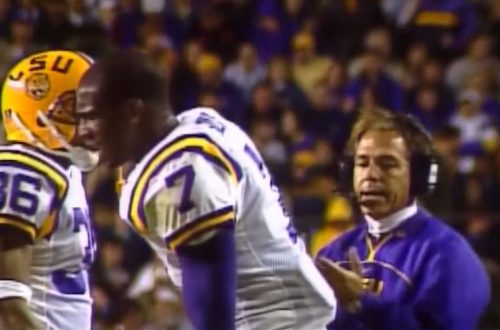 When the sanctions against Penn State came down on Monday, readers asked me whether or not I thought they were enough. In particular, folks wanted to know if I thought Penn State should have gotten the so-called “death penalty.” I’m a little ambivalent about that question, as I wrote about here. One thing I can say for sure. I think that the sanctions that Penn State received may turn out to be worse than the death penalty.
When the sanctions against Penn State came down on Monday, readers asked me whether or not I thought they were enough. In particular, folks wanted to know if I thought Penn State should have gotten the so-called “death penalty.” I’m a little ambivalent about that question, as I wrote about here. One thing I can say for sure. I think that the sanctions that Penn State received may turn out to be worse than the death penalty.
The death penalty has only been issued one time in the history of college football, and it was the SMU Mustangs that had to endure it. It’s been 25 years since the NCAA terminated SMU’s program for a year, and the Mustangs still haven’t recovered. The death penalty came to SMU in 1987, and they weren’t able to put together another winning season until 2009—some 22 year after the sanction. Even today, SMU is nowhere near the team they were back in the early 80’s.
How do the sanctions against Penn State measure-up against the death penalty that SMU received? In college football, recruiting is everything. If you can recruit blue chip prospects, then you can win football games and compete at the elite level. If you cannot recruit, then you cannot win. At SMU, the “death penalty” effectively shut down SMU’s recruiting for two years. At Penn State, the sanctions effectively shut down recruiting for the next four years.
In addition, the scholarships have been so diminished that Penn State has effectively been reduced to a Division II program. Penn State will be a team of walk-ons in very short order. In 1989, SMU was so diminished that their inferior talent allowed the University of Houston to score 95 points against them in one game. You can expect to see similar spectacles in the coming years as Penn State will have to continue playing in the Big 10 after their talent dries up. It’s not going to be pretty.
If it’s all about recruiting, then Penn State has a long road ahead of them. SMU has shown us that. And that is why Penn State’s penalty may turn out to be worse than SMU’s.
In 2010, ESPN produced a documentary about SMU and the death penalty. It’s fascinating to watch. If you want to see what happens when a team is no longer able to recruit, watch this video. It’s titled “Pony Excess,” and you can watch the whole thing below.




3 Comments
Barry Joslin
I see your point, but if covering up child rape doesn’t demand the death penalty, then pray tell, what does? That’s my biggest beef with this. And who says the death penalty can only be for one season? Why not give them the so-called death penalty for two or more years? In the end, you may be right that the resulting effects may be worse than SMU, but there is something that does not sit right when SMU can receive the death penalty for their infractions and Penn St not when children’s lives have been ruined. Fie and hell on Penn State’s program for this. I hope they never recover, and aren’t glorified as martyr. There would have been a stronger message sent to college football as well as to the families and people affected by Sandusky’s perversions had the program been shelved for multiple years.
Barry
Denny Burk
At SMU, the coaches, the administration, the alumni boosters, AND the players were all complicit in the scandal.
At Penn State, the Freeh report places the blame for the scandal at the feet of only four leaders. You can’t rightly blame the Penn State scandal on the players, the students, the alumni, or the people of State College. It really comes down to Sandusky and the four people who perpetrated a cover-up.
The crime was worse at Penn State, but the circle of responsible individuals seems to be smaller. That’s the difference I see here. But as I said before, I’m ambivalent about it.
Jose Rodriguez
I believe part of the reason for the “death penalty’s” devastating effect on SMU’s football program was because the school itself decided not to go back to big time D-1 football after they served their time. Further, I believe they also raised the academic standards so high that it virtually eliminated the possibility of them getting blue chip talent. Again, I have no sources to back this up but I seem to remember reading it somewhere.
As for Penn State, I keep seeing comments about how the entire school or the entire athletic department should not be punished for the actions of others. To that I say that this scandal would never have happened if those at the highest levels of both the athletics department and even the school administration had done everything in their power to put a stop to the abuses as soon as they heard about them.
The sanctions are as much a warning to all NCAA schools as well as an indictment on PSU: the $60 million to make them feel the sting of lost revenues, the playoff/bowl ban to show them the non-importance of football in the face of this tragedy, and the vacating of wins (both for the university as well as for Joe Paterno) to show that no one person is above doing the right thing. Together these sanctions put on paper what the general public had already done: the complete annihilation of Joe Paterno’s (and Penn State’s), legacy for the last six decades. No amount of fines, bans, or vacated wins will give the victims back what they lost.